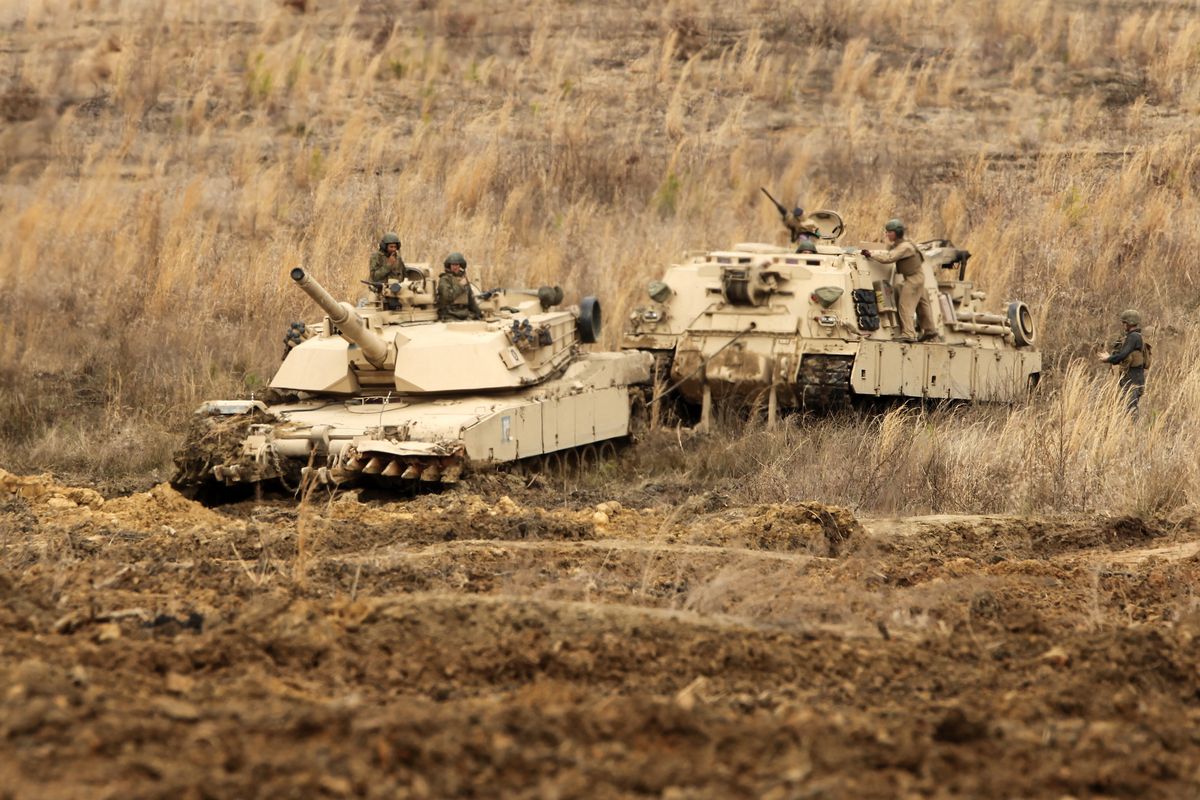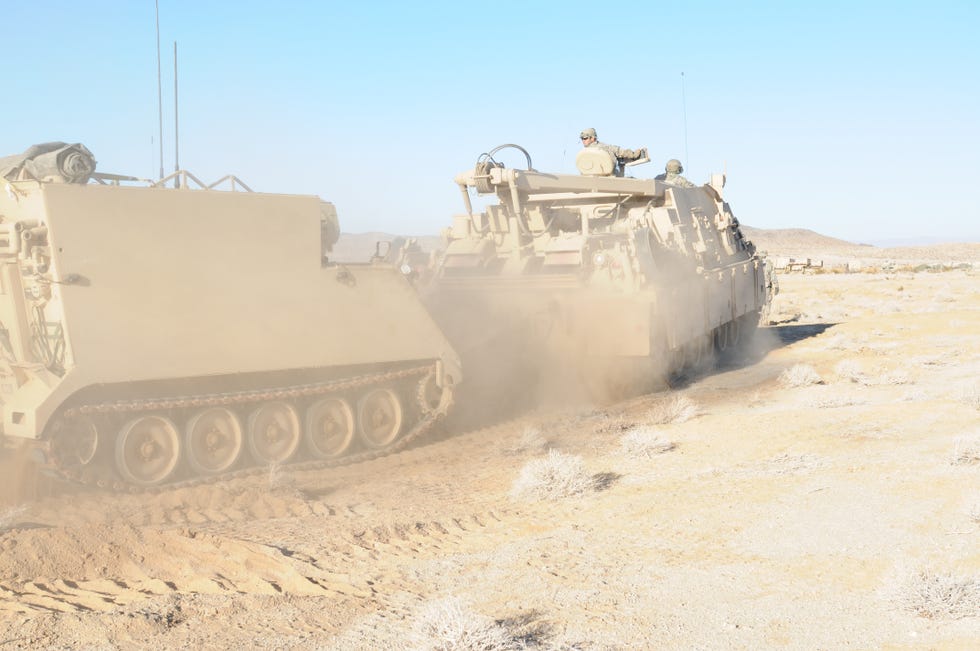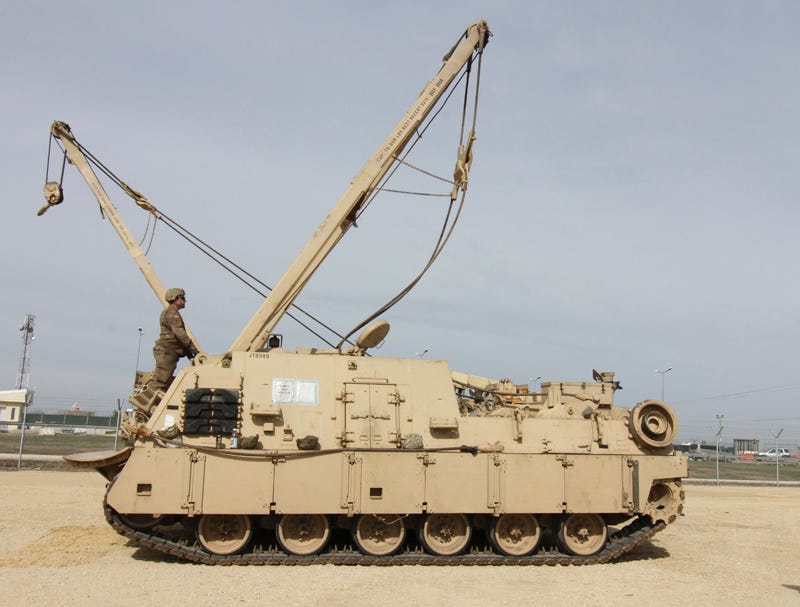KYLE MIZOKAMI

President Joe Biden announced late last month that he’s sending 31 M1A2 Abrams tanks to Ukraine—the equivalent of a Ukrainian tank battalion. But there’s another type of vehicle included in the $400 million aid package that has been lost in the headlines: the M88A2 Hercules, the standard heavy recovery vehicle of the U.S. Army.
First fielded in the 1960s, the Hercules has been upgraded over the past half-century to deal with larger, heavier tanks. The deployment of eight M88s to Ukraine means the Pentagon not only wants to keep the tanks fighting, but is concerned that Abrams tanks abandoned on the battlefield could fall into Russian hands.
What Is the M88 Hercules?

An M88A2 Hercules uses its A-frame winch to lift the power pack from an M1A2SEPv3 in Drawsko Pomorskie, Poland, October 27, 2022.SPC Kevin Brown/DVIDS
The invention of the tank, a heavily armed and armored fighting vehicle, signaled a major shift in land warfare in the early 20th century. Like all land vehicles, tanks break down, and sometimes need a tow. This is a particular problem for tanks, which suffer damage from enemy fire, cross-country travel, and the excessive wear of operating under wartime conditions.
In 1961, the U.S. Army fielded the M88 Heavy Equipment Recovery Combat Utility Lifting Extraction System (HERCULES). The M88 was designed to assist tanks: pulling tanks out of mud and other natural obstacles, uprighting overturned tanks, and most importantly, taking damaged tanks off the front line and to the rear where they can be repaired.
The M88 includes an A-frame winch and a dozer blade. The dozer blade, or “spade,” as the Army calls it, allows a Hercules to dig in and anchor itself while it pulls tanks in distress. The A-frame allows the Hercules to lift tank turrets and engines up and off the vehicle for service or repair purposes. The armored cab keeps the crew of four safe from heavy machine gun and artillery shrapnel.
Hercules Gets Stronger

An M88A2 Hercules tows an M577 Command Post Carrier, National Training Center, 2013.U.S. Army Photo/ Sgt. Tanangachi Mfuni, 7th MPAD
The M88 was eventually updated to the M88A1 standard, which included a more powerful Continental AVDS-1790-2DR diesel engine with an output of 750 horsepower. The M88A1 could tow up to 56 tons and lift 25 tons. However, as an upgraded version of the Army’s Abrams tank entered service in the mid-1980s, the service realized it had a problem: the new version was a heavy lift for even the mighty Hercules.
At the start of its career, the M1 Abrams main battle tank weighed 55 tons, which was considered very heavy for the time. This was quickly followed by the M1A1, an upgrade that included the adoption of depleted uranium armor, which weighs 2.5 times more than steel, a larger 120-millimeter smoothbore gun, and other upgrades. The latest version, the M1A2SEPv3, weighs a staggering 73.6 tons, making it one of the heaviest tanks in the world.
The U.S. Army of the 1980s and 1990s made do with the M88A1 by daisy-chaining two of them to pull a single M1A1. This was not a great solution, as it tied up two M88s on a single job, so in the 1990s, the Army developed the M88A2. Also used by the Marines, the M88A2 could tow up to 80 tons and winch-lift up to 35 tons. This once again allowed a single M88A2 to service a single Abrams tank. Unlike previous versions of the M88, which were type-classified as Medium Recovery Vehicles, this bump in capability led to the M88A2 being upgraded to a Heavy Recovery Vehicle.
Protecting Abrams Tanks’ Secrets

An M88A2 Heavy Equipment Recovery Combat Utility Lifting Extraction System during familiarization training at Mihail Koglaniceanu Air Base, Romania, March 16, 2019.U.S. Army photo by Staff Sgt. True Thao
The Pentagon is sending eight M88A2s to Ukraine along with 31 Abrams tanks. There are two reasons for this. The first reason is that the Abrams is a fairly complex piece of equipment, and while Ukrainian troops will be trained to maintain the tanks, they won’t have experienced Abrams maintainers. Abrams tanks may need to spend more time in rear areas undergoing maintenance, and they will need vehicles to tow them.
Another issue is that the Pentagon is almost certainly nervous about Russian troops capturing an Abrams and learning its secrets. If a Ukrainian M1 suffers a breakdown or is damaged on the battlefield, it could end up being towed away by the wrong side. Ukrainian troops are under strict orders to destroy high-tech Western equipment, such as the Javelin missile, if they are threatened with capture. But a 73-ton, heavily armored tank is another matter entirely. If a Ukrainian Army Abrams becomes a battlefield casualty, the Department of Defense wants to make sure the means are available to evacuate it as soon as possible.
The Hercules is an unglamorous, but absolutely essential, vehicle for any mechanized army. An immobile tank is a liability to any army, especially in wartime, and vehicles like the M88A2 can keep a combined arms force like the U.S. Army rolling as it races to reach its objectives. Like a lot of equipment headed east lately, it’s unlikely its designers ever foresaw the day when it would be supplied to an ex-Soviet army to fight another ex-Soviet army.
No comments:
Post a Comment